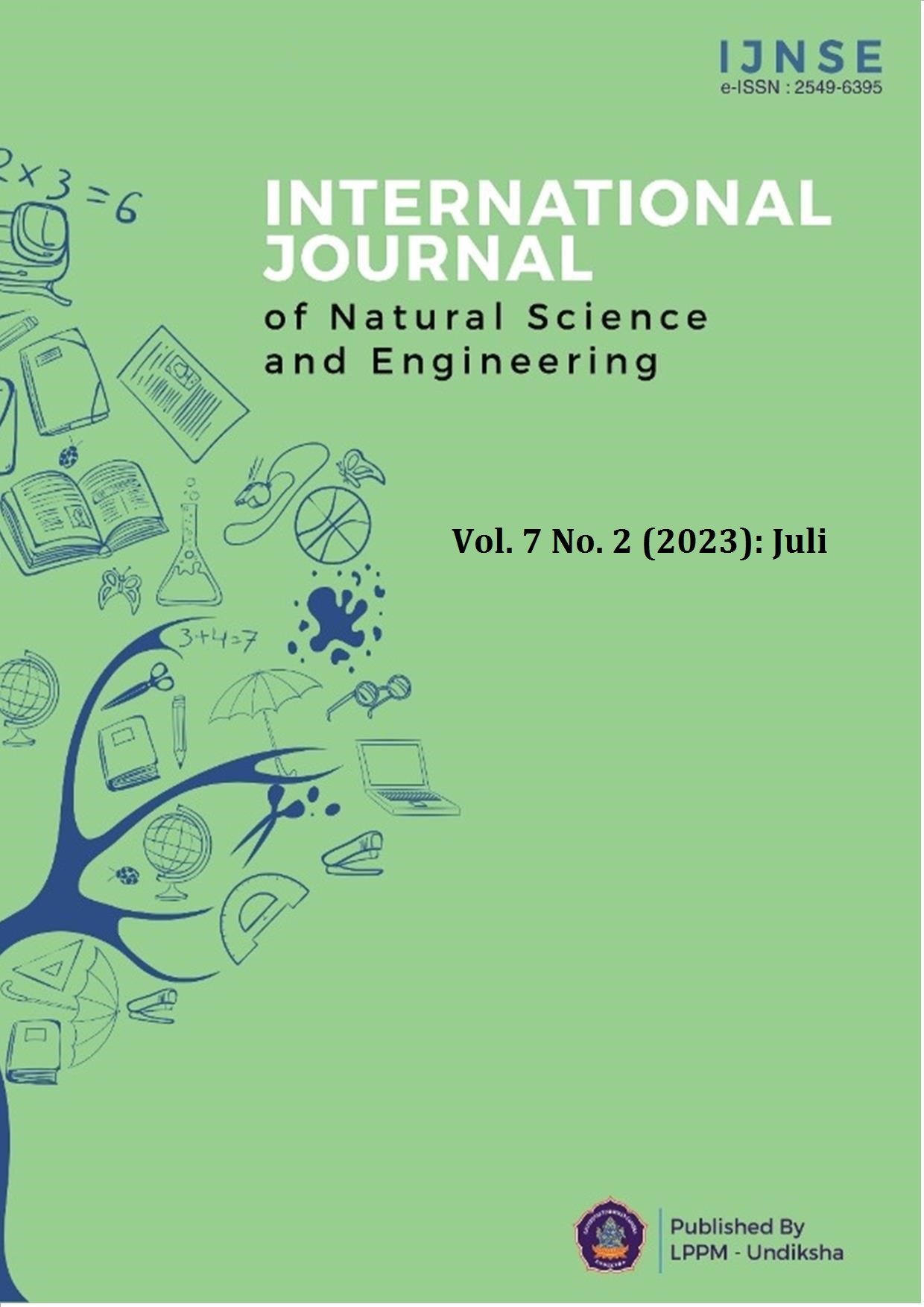The Effect of Graphene Oxide Biomass as Filtration Loss Control Agent of Water-Based Mud Fluid
DOI:
https://doi.org/10.23887/ijnse.v7i2.48181Kata Kunci:
Graphene Oxide, Oil Palm Shell, Filtration Loss, Drilling FluidAbstrak
Water-based drilling fluids are complex chemical systems that are essential for water drilling excavation. Biomass of Graphene Oxide (GO) is a submicrometer-thick material with unique and specific properties. GO can be entirely impermeable to liquids, vapors, and gases. It has water dispersibility and a huge specific surface area that is the potential material suitable for filtration loss control agents of water-based mud fluid. This study aims to analyze the effectiveness of Oil Palm Shell Graphene Oxide Biomass as an additif material to filtration control in water-based mud fluid. Making GO biomass sample starts from biomass Oil Palm Shell into graphite biomass, then the graphite biomass was sinthesized using an ultrasound-assisted liquid Phase Exfoliation (LPE) method to obtain thin GO biomass. Graphite biomass and GO biomass were characterized using FTIR, UV-Vis Spectroscopy and SEM-EDX. Drilling fluid samples with graphite biomass and GO biomass were prepared by adding 0.5 gr Graphite biomass and GO biomass into the based fluid (water-based bentonite fluid), The Filtration loss and the mud cake thickness of all the samples are measured and compared. Based on the measurement results, GO biomass additive is very effective in reducing fluid loss compare to graphite biomass additif. The volume of fluid lost was decreases from 13.9 ml to 10.8 ml compare to graphite biomass which was only able to decrease it to 12,3 ml.
Referensi
Adesina, F., Anthony, A., Gbadegesin, A., Eseoghene, O., & Oyakhire, A. (2012). Environmental impact evaluation of a safe drilling mud. Society of Petroleum Engineers - SPE Middle East Health, Safety, Security, and Environment Conf. and Exhibition 2012, MEHSSE - Sustaining World Energy Through an Integrated HSSE and Business Approach, 388–396. https://doi.org/10.2118/152865-ms. DOI: https://doi.org/10.2118/152865-MS
API. (2003). Recommended Practice for Field Testing of Oil-based Drilling Fluids. 2001(March).
Aramendiz, J., & Imqam, A. (2019). Silica and graphene oxide nanoparticle formulation to improve thermal stability and inhibition capabilities of water-based drilling fluid applied to woodford shale. Proceedings - SPE International Symposium on Oilfield Chemistry, 2019(April), 8–9. https://doi.org/10.2118/193567-ms. DOI: https://doi.org/10.2118/193567-MS
Banerjee, A. N. (2018). Graphene and its derivatives as biomedical materials: Future prospects and challenges. Interface Focus, 8(3). https://doi.org/10.1098/rsfs.2017.0056. DOI: https://doi.org/10.1098/rsfs.2017.0056
Behnamanhar, H., Shamsollah Noorbakhsh, S., & Maghsoudloojafari, H. (2014). Environmentally Friendly Water-Based Drilling Fluid for Drilling of Water-Sensitive Formations. Journal of Petroleum and Gas Exploration Research, 4(4), 60–71. http:/dx.doi.org/10.14303/jpger.2014.018%5Cnhttp://www.interesjournals.org.
Dehghani, F., Kalantariasl, A., Saboori, R., Sabbaghi, S., & Peyvandi, K. (2019). Performance of carbonate calcium nanoparticles as filtration loss control agent of water-based drilling fluid. SN Applied Sciences, 1. https://doi.org/10.1007/s42452-019-1446-8. DOI: https://doi.org/10.1007/s42452-019-1446-8
Deng, W., Fang, Q., Huang, H., Zhou, X., Ma, J., & Liu, Z. (2017). Oriented Arrangement: The Origin of Versatility for Porous Graphene Materials. Small, 13(34). https://doi.org/10.1002/smll.201701231. DOI: https://doi.org/10.1002/smll.201701231
Dreyer, D. R., Park, S., Bielawski, C. W., & Ruoff, R. S. (2010). The chemistry of graphene oxide. Chemical Society Reviews, 39(1), 228–240. https://doi.org/10.1039/b917103g. DOI: https://doi.org/10.1039/B917103G
Eda, G., & Chhowalla, M. (2010). Chemically derived graphene oxide: Towards large-area thin-film electronics and optoelectronics. Advanced Materials, 22(22), 2392–2415. https://doi.org/10.1002/adma.200903689. DOI: https://doi.org/10.1002/adma.200903689
Fu, L., Liao, K., Tang, B., Jiang, L., & Huang, W. (2020). Applications of graphene and its derivatives in the upstream oil and gas industry: A systematic review. Nanomaterials, 10(6). https://doi.org/10.3390/nano10061013. DOI: https://doi.org/10.3390/nano10061013
Ghazali, N. A., Alias, N. H., Mohd, T. A. T., Adeib, S. I., & Noorsuhana, M. Y. (2015). Potential of Corn Starch as Fluid Loss Control Agent in Drilling Mud. Applied Mechanics and Materials, 754–755, 682–687. https://doi.org/10.4028/www.scientific.net/amm.754-755.682. DOI: https://doi.org/10.4028/www.scientific.net/AMM.754-755.682
Ghazali, N. A., Mohd, T. A. T., Alias, N. H., Azizi, A., & Harun, A. A. (2014). The effect of lemongrass as lost circulation material (LCM) to the filtrate and filter cake formation. Key Engineering Materials, 594–595(December), 68–72. https://doi.org/10.4028/www.scientific.net/KEM.594-595.68. DOI: https://doi.org/10.4028/www.scientific.net/KEM.594-595.68
Hamida, T., Kuru, E., & Pickard, M. (2010). Filtration loss characteristics of aqueous waxy hull-less barley (WHB) solutions. Journal of Petroleum Science and Engineering, 72(1–2), 33–41. https://doi.org/10.1016/j.petrol.2010.02.006. DOI: https://doi.org/10.1016/j.petrol.2010.02.006
He, D., Peng, Z., Gong, W., Luo, Y., Zhao, P., & Kong, L. (2015). Mechanism of a green graphene oxide reduction with reusable potassium carbonate. RSC Advances, 5(16), 11966–11972. https://doi.org/10.1039/c4ra14511a. DOI: https://doi.org/10.1039/C4RA14511A
Khodja, M., Khodja-Saber, M., Canselier, J. P., Cohaut, N., & Bergaya, F. (2010). Drilling Fluid Technology : Performances and Environmental Considerations, Products and Services. From R&D to Final Solutions, Igor Fuerstner (Ed.), 227–256. https://doi.org/10.5772/55742. DOI: https://doi.org/10.5772/10393
Kigozi, M., Koech, R. K., Kingsley, O., Ojeaga, I., Tebandeke, E., Kasozi, G. N., & Onwualu, A. P. (2020). Synthesis and characterization of graphene oxide from locally mined graphite flakes and its supercapacitor applications. Results in Materials, 7, 100113. https://doi.org/10.1016/j.rinma.2020.100113. DOI: https://doi.org/10.1016/j.rinma.2020.100113
Kosynkin, D. V., Ceriotti, G., Wilson, K. C., Lomeda, J. R., Scorsone, J. T., Patel, A. D., Friedheim, J. E., & Tour, J. M. (2012). Graphene oxide as a high-performance fluid-loss-control additive in water-based drilling fluids. ACS Applied Materials and Interfaces, 4(1), 222–227. https://doi.org/10.1021/am2012799. DOI: https://doi.org/10.1021/am2012799
Lyons, W. C. (1996). Standard Handbook of Petroleum & Natural Gas. Engineering, 1456.
Medhi, S., Chowdhury, Satyajit, Dharmender, ·, Gupta, K., & Aryab Mazumdar, ·. (n.d.). An investigation on the effects of silica and copper oxide nanoparticles on rheological and fluid loss property of drilling fluids. Journal of Petroleum Exploration and Production Technology. https://doi.org/10.1007/s13202-019-0721-y.
Monajjemi, M. (2017). Liquid-phase exfoliation (LPE) of graphite towards graphene: An ab initio study. Journal of Molecular Liquids, 230, 461–472. https://doi.org/10.1016/j.molliq.2017.01.044. DOI: https://doi.org/10.1016/j.molliq.2017.01.044
Mursyidah, Hadziqoh, N., Septian, R., & Khalid, I. (2019). PENGARUH UKURAN PARTIKEL ADITIF BIOMASS ACTIVATED. September, 978–979.
Nanda, S. S., Papaefthymiou, G. C., & Yi, D. K. (2015). Functionalization of Graphene Oxide and its Biomedical Applications. Critical Reviews in Solid State and Materials Sciences, 40(5), 291–315. https://doi.org/10.1080/10408436.2014.1002604. DOI: https://doi.org/10.1080/10408436.2014.1002604
Parizad, A., Shahbazi, K., & Tanha, A. A. (2018). SiO2 nanoparticle and KCl salt effects on filtration and thixotropical behavior of polymeric water based drilling fluid: With zeta potential and size analysis. Results in Physics, 9, 1656–1665. https://doi.org/10.1016/j.rinp.2018.04.037. DOI: https://doi.org/10.1016/j.rinp.2018.04.037
Sjahriza, A., & Herlambang, S. (2021). Sintesis Oksida Grafena dari Arang Tempurung Kelapa Untuk Aplikasi Antibakteri dan Antioksidan. Al-Kimiya, 8(2), 51–58. https://doi.org/10.15575/ak.v8i2.13473. DOI: https://doi.org/10.15575/ak.v8i2.13473
Smith, A. T., LaChance, A. M., Zeng, S., Liu, B., & Sun, L. (2019). Synthesis, properties, and applications of graphene oxide/reduced graphene oxide and their nanocomposites. Nano Materials Science, 1(1), 31–47. https://doi.org/10.1016/j.nanoms.2019.02.004. DOI: https://doi.org/10.1016/j.nanoms.2019.02.004
Song, L., Lv, K., & Zhang, Z. (2019). Synthesis of a Flexible Particle as a Lost Circulation Material in Drilling Fluids. IOP Conference Series: Earth and Environmental Science, 237(5). https://doi.org/10.1088/1755-1315/237/5/052059. DOI: https://doi.org/10.1088/1755-1315/237/5/052059
Supriyanto, G., Rukman, N. K., Nisa, A. K., Jannatin, M., Piere, B., Abdullah, Fahmi, M. Z., & Kusuma, H. S. (2018). Graphene oxide from Indonesian biomass: Synthesis and characterization. BioResources, 13(3), 4832–4840. https://doi.org/10.15376/biores.13.3.4832-4840. DOI: https://doi.org/10.15376/biores.13.3.4832-4840
Wachid, F. M., Perkasa, A. Y., Prasetya, F. A., Rosyidah, N., & Darminto. (2014). Synthesis and characterization of nanocrystalline graphite from coconut shell with heating process. AIP Conference Proceedings, 1586(February), 202–206. https://doi.org/10.1063/1.4866759. DOI: https://doi.org/10.1063/1.4866759
Yi, M., Shen, Z., Zhang, X., & Ma, S. (2013). Achieving concentrated graphene dispersions in water/acetone mixtures by the strategy of tailoring Hansen solubility parameters. Journal of Physics D: Applied Physics, 46(2). https://doi.org/10.1088/0022-3727/46/2/025301. DOI: https://doi.org/10.1088/0022-3727/46/2/025301
Zamani, A., Bataee, M., Hamdi, Z., & Khazforoush, F. (2019). Application of smart nano-WBM material for filtrate loss recovery in wellbores with tight spots problem: an empirical study. Journal of Petroleum Exploration and Production Technology, 9(1), 669–674. https://doi.org/10.1007/s13202-018-0500-1. DOI: https://doi.org/10.1007/s13202-018-0500-1





